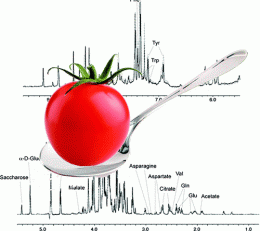'Magnetic tongue' ready to help produce tastier processed foods

The "electronic nose," which detects odors, has a companion among emerging futuristic "e-sensing" devices intended to replace abilities that once were strictly human-and-animal-only. It is a "magnetic tongue" -- a method used to "taste" food and identify ingredients that people describe as sweet, bitter, sour, etc. A report on use of the method to taste canned tomatoes appears in ACS' Journal of Agricultural and Food Chemistry.
Antonio Randazzo, Anders Malmendal, Ettore Novellino and colleagues explain that sensing the odor and flavor of food is a very complex process. It depends not only on the combination of ingredients in the food, but also on the taster's emotional state. Trained taste testers eliminate some of the variation, but food processors need more objective ways to measure the sensory descriptor of their products. That's where electronic sensing technologies, like E-noses, come into play.
However, current instruments can only analyze certain food components and require very specific sample preparation. To overcome these shortcomings, Randazzo and Malmendal's team turned to nuclear magnetic resonance spectroscopy (NMR) to test its abilities as "a magnetic tongue."
The researchers analyzed 18 canned tomato products from various markets with NMR and found that the instrument could estimate most of the tastes assessed by the human taste testers. But the NMR instrument went even farther. By determining the chemical composition, it showed which compound is related to which sensory descriptor. The researchers say that the "magnetic tongue" has good potential as a rapid, sensitive and relatively inexpensive approach for food processing companies to use.
More information: NMR Spectrometers as “Magnetic Tongues”: Prediction of Sensory Descriptors in Canned Tomatoes, J. Agric. Food Chem., 2011, 59 (20), pp 10831–10838. DOI: 10.1021/jf203803q
Abstract
The perception of odor and flavor of food is a complicated physiological and psychological process that cannot be explained by simple models. Quantitative descriptive analysis is a technique used to describe sensory features. Nevertheless, the availability of a number of instrumental techniques has opened up the possibility to calibrate the sensory perception. In this frame, we have tested the potentiality of nuclear magnetic resonance spectroscopy as a predictive tool to measure sensory descriptors. In particular, we have used an NMR metabolomic approach that allowed us to differentiate the analyzed samples based on their chemical composition. We were able to correlate the NMR metabolomic fingerprints recorded for canned tomato samples to the sensory descriptors bitterness, sweetness, sourness, saltiness, tomato and metal taste, redness, and density, suggesting that NMR might be a very useful tool for the characterization of sensory features of tomatoes.
Provided by American Chemical Society

















